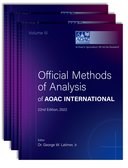 Official Methods of Analysis of AOAC INTERNATIONAL (22nd Edition)
Official Methods of Analysis of AOAC INTERNATIONAL (22nd Edition)
Contents
45.1.24
AOAC Official Method 971.30
α-Tocopherol and α-Tocopheryl Acetate in Foods and Feeds: Colorimetric Method
Get access
-
Published:January 2023
Cite
α-Tocopherol and α-Tocopheryl Acetate in Foods and Feeds: Colorimetric Method', in Dr. George W Latimer, Jr. (ed.), Official Methods of Analysis of AOAC INTERNATIONAL, 22nd Edition (
Extract
First Action 1971
Final Action 1972
Principle
Following methods are designed to determine vitamin E in foods and feeds in the several forms in which it may occur. Unsupplemented food or feed will contain natural α-tocopherol associated with many other reducing substances. This type of product is extracted, lipid residue saponified, and α-tocopherol isolated by TLC and determined colorimetrically. Foods or feeds may be supplemented with α-tocopheryl acetate added either as oil or in various dry forms. Assay for total α-tocopherol (natural plus supplemental) follows same operations described above. To specifically determine α-tocopheryl acetate, test portion is extracted, reducing substances, including natural α-tocopherol, are removed by oxidative chromatography, α-tocopheryl acetate is saponified, and resulting α-tocopherol is determined colorimetrically.
Calculation of assay results for supplemented foods and feeds in terms of International Units (IU) is complicated by fact that natural and synthetic α-tocopheryl acetates have different weight-activity factors. α-Tocopherol occurring naturally is in RRR-form. With products supplemented with RRR-α-tocopheryl acetate (natural), resulting total α-tocopherol is all in RRR-form and IU potency of product can readily be determined by using appropriate factor. With products supplemented with all-rac-α-tocopheryl acetate (synthetic), resulting total α-tocopherol is mixture of RRR- and all-rac-forms. To convert to IU, level of supplementation with all-rac-α-tocopheryl acetate must be determined specifically and natural α-tocopherol is determined by difference. Appropriate factors are then separately applied to determined levels of RRR- and all-rac-forms and results are added to determine IU potency of product. If isomeric nature of supplement is not known, it must be determined separately, 975.43 (see 45.1.25), before IU potency of supplemented products can be determined.
Sign in
Personal account
- Sign in with email/username & password
- Get email alerts
- Save searches
- Purchase content
- Activate your purchase/trial code
- Add your ORCID iD
Purchase
Our books are available by subscription or purchase to libraries and institutions.
Purchasing information| Month: | Total Views: |
|---|---|
| March 2024 | 1 |
| April 2024 | 3 |
| May 2024 | 5 |
| June 2024 | 3 |
| July 2024 | 11 |
| August 2024 | 3 |
| September 2024 | 2 |
| October 2024 | 8 |
| November 2024 | 1 |
| December 2024 | 11 |
| January 2025 | 6 |
| February 2025 | 6 |
| April 2025 | 6 |




Get help with access
Institutional access
Access to content on Oxford Academic is often provided through institutional subscriptions and purchases. If you are a member of an institution with an active account, you may be able to access content in one of the following ways:
IP based access
Typically, access is provided across an institutional network to a range of IP addresses. This authentication occurs automatically, and it is not possible to sign out of an IP authenticated account.
Sign in through your institution
Choose this option to get remote access when outside your institution. Shibboleth/Open Athens technology is used to provide single sign-on between your institution’s website and Oxford Academic.
If your institution is not listed or you cannot sign in to your institution’s website, please contact your librarian or administrator.
Sign in with a library card
Enter your library card number to sign in. If you cannot sign in, please contact your librarian.
Society Members
Society member access to a journal is achieved in one of the following ways:
Sign in through society site
Many societies offer single sign-on between the society website and Oxford Academic. If you see ‘Sign in through society site’ in the sign in pane within a journal:
If you do not have a society account or have forgotten your username or password, please contact your society.
Sign in using a personal account
Some societies use Oxford Academic personal accounts to provide access to their members. See below.
Personal account
A personal account can be used to get email alerts, save searches, purchase content, and activate subscriptions.
Some societies use Oxford Academic personal accounts to provide access to their members.
Viewing your signed in accounts
Click the account icon in the top right to:
Signed in but can't access content
Oxford Academic is home to a wide variety of products. The institutional subscription may not cover the content that you are trying to access. If you believe you should have access to that content, please contact your librarian.
Institutional account management
For librarians and administrators, your personal account also provides access to institutional account management. Here you will find options to view and activate subscriptions, manage institutional settings and access options, access usage statistics, and more.